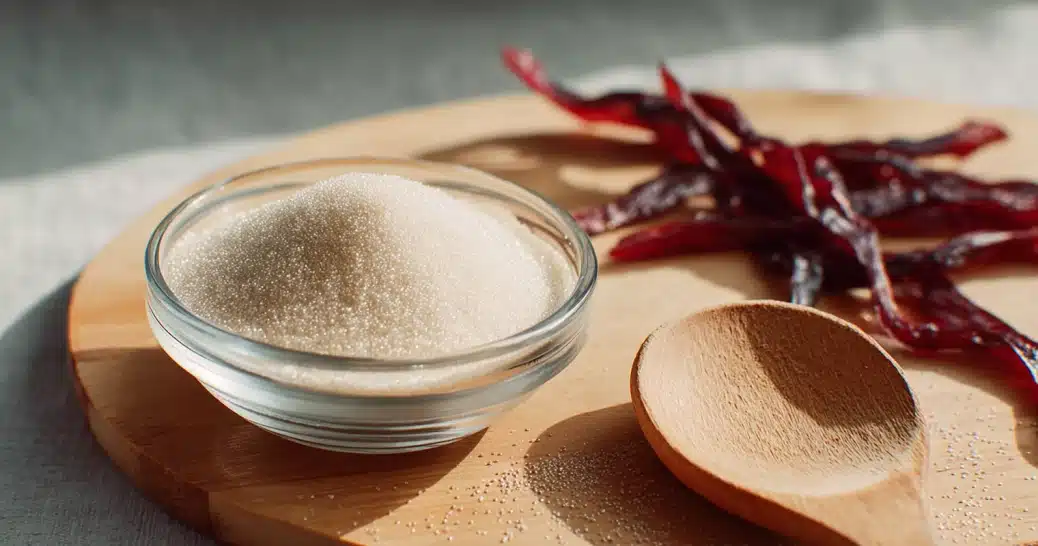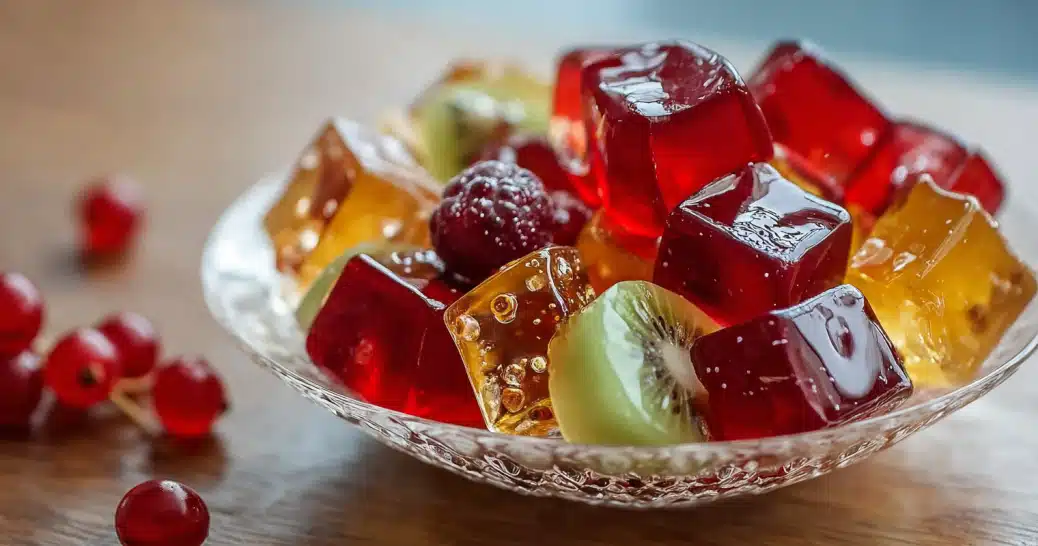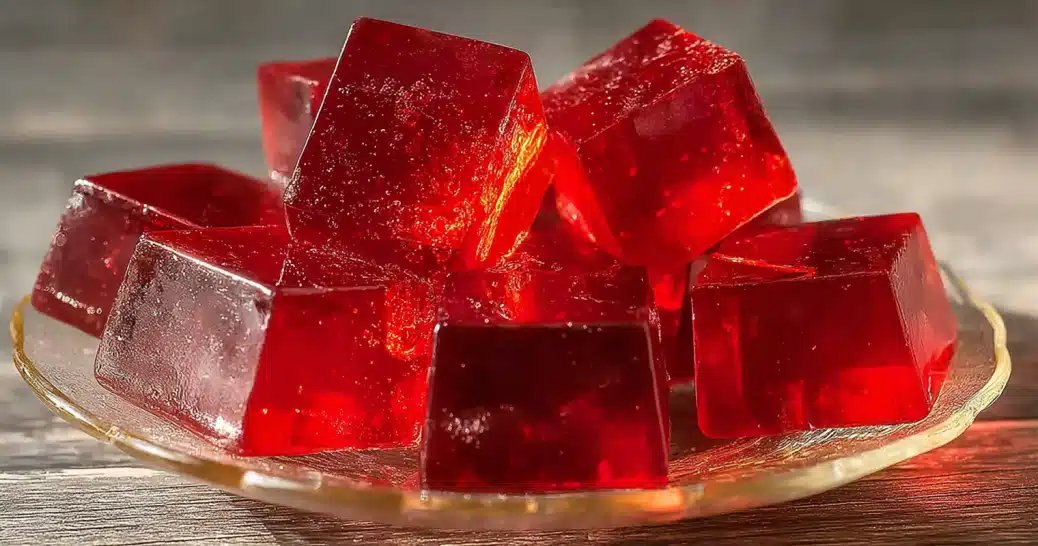Ever tried to make jelly without gelatin? That is where agar agar powder steps in, a seaweed-based thickener that has changed the way vegan and halal kitchens create desserts. Made from red algae, this natural gelling agent offers a firm, clean set and works perfectly in fruit jellies, panna cotta, or even marshmallows. Agar agar powder is not just a substitute, it is a whole new way to build texture in cooking while staying completely plant-based.
In this guide, you will learn what agar agar powder is, how it is produced, why people love it, and the simple ways to use it for both sweet and savory dishes. Whether you are a vegan cook, a baker exploring new ingredients, or simply curious about gelatin-free desserts, this article will show you everything you need to know about agar agar powder and how to use it with confidence.
Table of Contents
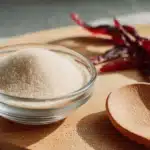
Agar Agar Powder: The Ultimate Plant-Based Gelatin Alternative Guide
- Total Time: 10 minutes
- Yield: 2–4 servings 1x
- Diet: Vegan
Description
A simple, vegan-friendly fruit jelly made with agar agar powder — a plant-based gelling agent from seaweed. Light, healthy, and easy to customize.
Ingredients
1 teaspoon agar agar powder
1 cup fruit juice (apple, mango, or grape)
1–2 tablespoons sugar (optional)
Optional: fruit slices, mint leaves, or edible flowers
Instructions
1. In a saucepan, mix agar powder with fruit juice. Stir well to combine and add sugar if desired.
2. Bring to a full boil over medium heat, stirring constantly for 1–2 minutes to activate agar.
3. Remove from heat and pour mixture into molds, cups, or a dish.
4. Let cool at room temperature for 30 minutes, then refrigerate until firm (about 1 hour).
5. Unmold or slice and serve chilled. Store leftovers in the fridge.
Notes
Agar agar sets firmly and is ideal for vegan, halal, or allergy-friendly diets. Always boil to activate. Acidic juices may require slightly more agar for a firm set. Try flavor variations like coconut jelly or layered fruit blends.
- Prep Time: 5 minutes
- Cook Time: 5 minutes
- Category: Dessert
- Method: Chill
- Cuisine: Vegan
Nutrition
- Serving Size: 1 small jelly cup
- Calories: 25
- Sugar: 3g
- Sodium: 5mg
- Fat: 0g
- Saturated Fat: 0g
- Unsaturated Fat: 0g
- Trans Fat: 0g
- Carbohydrates: 6g
- Fiber: 1g
- Protein: 0g
- Cholesterol: 0mg
Understanding Agar Agar Powder
What is Agar Agar Powder and Where Does It Come From
Agar agar powder is a natural gelling agent derived from red seaweed, most commonly from the species Gracilaria and Gelidium. It is dried, processed, and ground into a fine, white powder that dissolves in hot liquid and sets when cooled. Unlike animal-based gelatin, agar agar is entirely plant-derived, making it suitable for vegan, vegetarian, kosher, and halal diets. The powder is flavorless and odorless, allowing it to take on the taste of whatever ingredients it is combined with, which is why it is popular in desserts, jellies, and even molecular gastronomy.
How Agar Agar Powder is Made from Seaweed
The production process begins with harvesting red seaweed from coastal waters, where it grows naturally. The seaweed is cleaned to remove sand and salt, then boiled to extract its gelatinous component. The resulting gel is cooled and dried before being crushed into flakes or milled into fine powder form. This careful process keeps agar agar’s gelling properties intact while ensuring it remains pure and safe for culinary use. Depending on the source seaweed and production method, agar’s strength can vary slightly, so testing ratios before large batches is always a smart move.
The History and Cultural Uses of Agar Agar in Asia
Agar agar has deep roots in Asian culinary traditions. It was first discovered in Japan during the 17th century, where it is known as “kanten.” From there, it spread throughout Asia and became a key ingredient in many local cuisines. In Japan, it is used in desserts such as yokan, a jelly-like sweet made from red bean paste. In the Philippines, gulaman is a popular jelly drink made from agar strips, while in Malaysia and Indonesia, agar agar powder is used in colorful layered desserts. Over time, its versatility and plant-based nature helped it reach global kitchens, where it now serves as the top vegan gelatin alternative.
Agar Agar Powder vs Gelatin – Key Differences
Source and Composition Comparison
The biggest difference between agar agar powder and gelatin lies in their origin. Gelatin comes from animal collagen, typically extracted from bones, skin, and connective tissue. In contrast, agar agar powder is made entirely from red seaweed, making it 100 percent plant-based. Because of this, agar agar fits perfectly into vegan, vegetarian, halal, and kosher diets. While gelatin contains proteins and amino acids, agar agar is mainly composed of polysaccharides, providing structure through natural plant fibers rather than animal protein. This key distinction makes agar agar a sustainable and cruelty-free choice for anyone avoiding animal products.
| Feature | Agar Agar Powder | Gelatin |
|---|---|---|
| Source | Red seaweed (plant-based) | Animal collagen |
| Texture | Firm, brittle set | Soft, jiggly set |
| Setting Temperature | Boils to activate, sets around 100°F | Melts at body temperature (~95°F) |
| Flavor | Neutral | Neutral |
| Dietary Suitability | Vegan, halal, kosher | Non-vegan only |
| Requires Boiling | Yes | No |
This difference in structure also affects how each performs in recipes. Agar agar sets more firmly and remains stable at room temperature, while gelatin tends to soften or melt in warmer conditions.
Texture, Setting Temperature, and Stability
If you want a dessert that keeps its shape at a warm event or during summer, agar agar powder is your best bet. It sets much firmer than gelatin and holds its texture even when left out for hours. Gelatin, on the other hand, melts easily and gives a soft, elastic, melt-in-the-mouth feel. Agar’s firm and glossy set makes it ideal for molded jellies, terrines, or desserts that need clean, defined edges. The key difference in setting temperature is that agar agar must be boiled to activate its gelling power, while gelatin dissolves in warm water. Once agar agar cools, it solidifies quickly and does not melt again unless reheated above boiling point.
For bakers and dessert makers, understanding these temperature differences is essential. If you are layering desserts or working with fruit juices, agar agar’s strength can help your creations hold shape beautifully without refrigeration.
Which is Better for Vegan and Halal Diets
When it comes to dietary restrictions, agar agar powder clearly wins. Since it is derived from plants, it is suitable for vegan, vegetarian, halal, and kosher diets. Gelatin, being animal-based, is excluded from all these categories unless it is specifically certified halal or kosher. Many people also choose agar agar because it is allergen-free, gluten-free, soy-free, and non-GMO, making it safe for people with food sensitivities.
For those following a vegan or halal lifestyle, agar agar powder is not just a replacement for gelatin, it is a superior alternative that aligns with both ethical and health-conscious cooking. It also adds a firmer texture that holds up well in recipes requiring precision or structure, like panna cotta, vegan marshmallows, or multi-layer fruit jellies.
Benefits of Using Agar Agar Powder
Plant-Based and Allergy-Friendly Features
One of the greatest benefits of agar agar powder is that it is completely plant-based. Made from red seaweed, it is free from animal ingredients, which makes it a perfect option for people following vegan, vegetarian, halal, or kosher diets. It is also naturally free from gluten, soy, and dairy, making it suitable for those with food allergies or sensitivities. Because it is flavorless and colorless, agar agar can blend easily into both sweet and savory recipes without altering their taste. For anyone looking to replace gelatin with a clean, cruelty-free option, agar agar powder delivers the same structure and reliability in cooking.
Unlike gelatin, agar agar powder is stable at room temperature. You can create jellies or layered desserts that do not melt easily when displayed. Its high gelling power means you can use less quantity while still achieving a firm set, making it cost-effective and efficient in the kitchen.
Health and Nutritional Benefits of Agar Agar
Agar agar powder offers several health perks in addition to its functional use. It is naturally rich in soluble fiber, which can support digestive health and promote a feeling of fullness. This makes it popular among those who want to manage appetite or follow a calorie-conscious diet. The fiber in agar acts as a gentle natural laxative that may help regulate bowel movement and support gut health.
Agar agar powder is also extremely low in calories and carbohydrates. This makes it suitable for low-carb, keto, or weight management plans. Because it contains almost no fat or sugar, it can be added to desserts, puddings, or smoothies to improve texture without adding extra calories. Some nutrition experts note that agar may help reduce cholesterol absorption and aid detoxification by supporting natural gut motility.
| Nutrient | Benefit |
|---|---|
| Fiber | Promotes healthy digestion and satiety |
| Calories | Extremely low, ideal for light desserts |
| Fat | None |
| Sugar | None |
| Protein | Minimal, but helps balance macros |
| Carbohydrates | Very low and mostly fiber-based |
Including agar agar powder in your recipes adds structure while supporting a lighter, cleaner diet. It is a simple way to make your meals both nutritious and beautiful.
Environmental Impact of Choosing Seaweed-Based Gelling Agents
Choosing agar agar powder over gelatin also supports sustainability. Seaweed, the raw material for agar, grows quickly without the need for freshwater, fertilizers, or pesticides. It absorbs carbon dioxide from the atmosphere and releases oxygen, helping maintain ocean health. In contrast, gelatin production relies on livestock farming, which contributes to greenhouse gas emissions and resource use. By using agar agar powder, you support a more eco-friendly food system that aligns with the growing global demand for plant-based alternatives.
This environmental benefit adds to agar agar’s appeal, especially for conscious consumers who care about where their ingredients come from. Whether you are a home cook or a professional baker, switching to agar agar powder is a small but impactful way to create sustainable, delicious, and ethical recipes.
How to Use Agar Agar Powder in Cooking
The Right Ratios and Substitution Chart
Using agar agar powder correctly depends on understanding the right ratios. Agar agar is much stronger than gelatin, so you only need a small amount to achieve a firm set. The standard ratio is 1 teaspoon of agar agar powder per 1 cup of liquid, which produces a soft, jelly-like texture. If you want a firmer or more rubbery set, such as for gummies or shaped desserts, increase the agar slightly to 1½ teaspoons per cup. For agar flakes, use about 1 tablespoon of flakes for every cup of liquid since flakes are less concentrated.
The following chart helps you substitute and adjust quantities easily:
| Desired Texture | Agar Agar Powder | Agar Flakes | Gelatin Equivalent |
|---|---|---|---|
| Soft, wobbly set | ½ tsp per cup | 2 tsp per cup | 1 tsp gelatin |
| Medium set | 1 tsp per cup | 1 tbsp per cup | 2 tsp gelatin |
| Firm set | 1½ tsp per cup | 1½ tbsp per cup | 1 tbsp gelatin |
Keep in mind that the setting strength can vary depending on the liquid you use. Juices with high acidity, like lemon or pineapple, may require slightly more agar agar powder. Likewise, rich liquids like coconut milk may set softer, so testing a small batch first helps ensure the right firmness.
Boiling and Dissolving Agar Agar Powder Properly
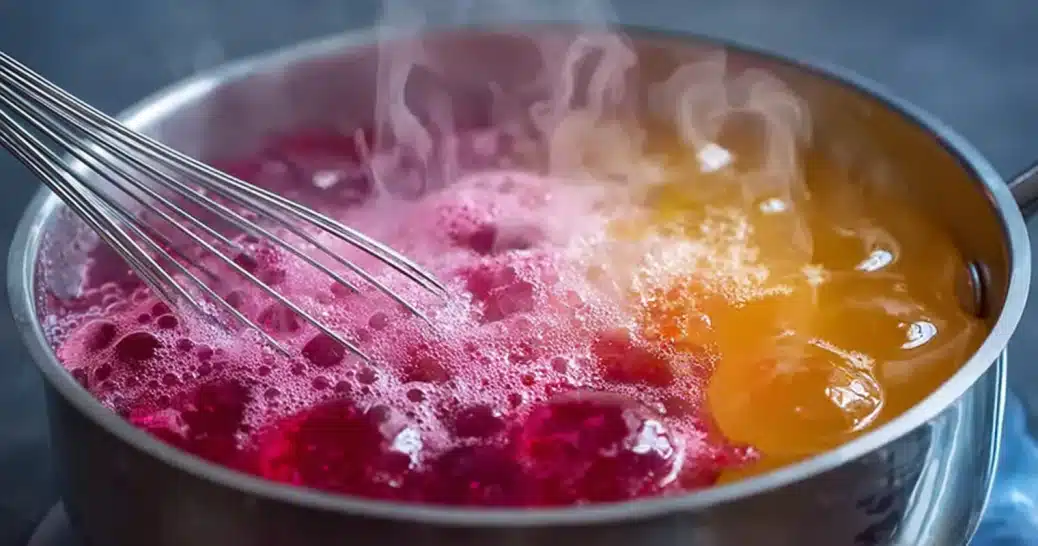
Agar agar powder must be boiled to activate its gelling power. Unlike gelatin, which dissolves in warm water, agar agar only fully dissolves in boiling liquid. Follow these simple steps for perfect results every time:
- Mix the powder into cold liquid first. This helps distribute it evenly and prevents clumping.
- Bring the mixture to a full rolling boil. Stir constantly until the powder completely dissolves.
- Simmer for 1 to 2 minutes. Once the liquid becomes clear, agar agar is fully activated.
- Pour into molds while still hot. Agar sets as it cools, so work quickly if layering or adding fruit.
- Let cool at room temperature. It will begin to firm up within 30 minutes and reach full strength after refrigeration.
Agar agar sets firmly even at room temperature and will not melt unless reheated above 185°F. This makes it ideal for desserts served outdoors or during warmer months.
Common Mistakes to Avoid When Using Agar Agar
While agar agar powder is easy to use, a few common mistakes can lead to uneven or weak results. Here is how to avoid them:
- Not boiling the mixture. Agar must reach boiling point to activate; warm water will not work.
- Adding it to hot liquid. Always start with cold liquid so the agar can disperse evenly before heating.
- Under-measuring. Using too little agar leads to soft or runny gels. Measure carefully with a teaspoon or scale.
- Over-acidic mixtures. Acidic fruits like lemon, kiwi, or pineapple can weaken agar’s setting power. To fix this, add a little extra agar or reduce the acidity by blending with less tart juices.
- Refrigerating too early. Let the mixture cool to room temperature first; sudden chilling can cause bubbles or uneven texture.
When used correctly, agar agar powder gives desserts a clean, glossy finish and precise structure. Its fast-setting nature also allows you to create layered jellies or decorative molds in less time than gelatin.
Desserts and Dishes Made with Agar Agar Powder
Best Sweet Recipes with Agar Agar (Jellies, Panna Cotta, Gummies)
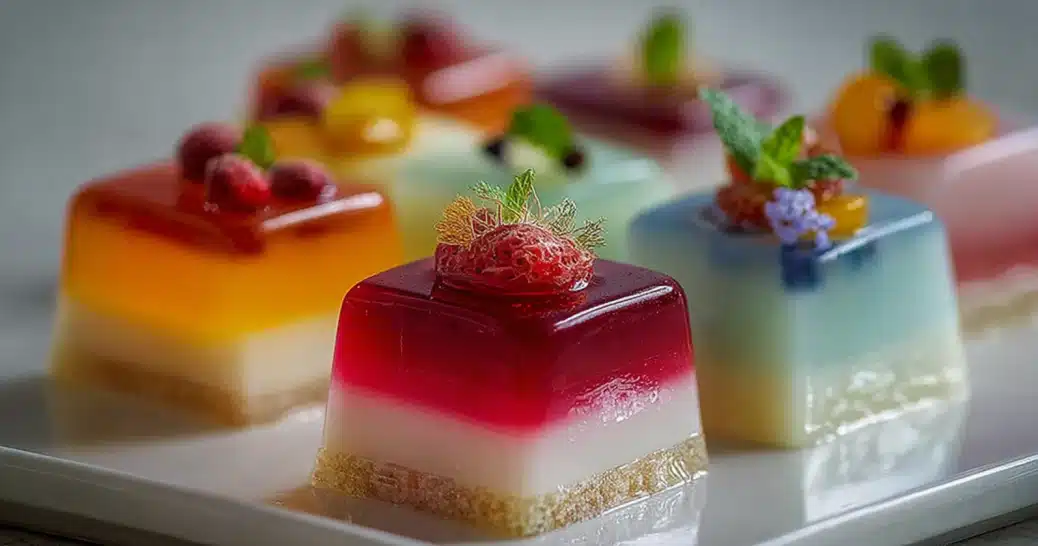
Agar agar powder shines brightest in desserts, especially those that traditionally rely on gelatin. Its ability to create a firm, glossy texture without animal ingredients makes it a favorite in vegan and allergy-friendly baking. You can use it to make a wide range of sweet recipes, from simple jellies to elegant no-bake creations.
Some of the most popular desserts that use agar agar powder include:
- Fruit Jellies: These are vibrant, sliceable, and easy to flavor with real fruit juice. Agar agar gives them a smooth, glass-like finish and keeps their shape even at room temperature.
- Vegan Panna Cotta: A creamy and silky Italian dessert made with coconut milk or almond milk instead of dairy. Agar agar provides the perfect set without compromising flavor or texture.
- Homemade Gummies: Kids love them, and adults do too. Using agar agar instead of gelatin creates firm yet chewy candies that are completely plant-based and customizable with natural fruit purees.
- No-Bake Cheesecakes: Agar helps the filling hold its shape and slice cleanly, even without refrigeration. It also prevents watery separation that often occurs in gelatin-based recipes.
- Marshmallows and Jello Cakes: Perfect for celebrations, these treats keep their shape and bounce thanks to agar agar’s high gelling power.
Agar agar’s neutral flavor makes it perfect for both classic and modern desserts. You can experiment with flavored layers, color gradients, or edible flowers suspended within the gel for stunning visual appeal.
Savory Recipes That Use Agar Agar Powder
Agar agar powder is not limited to desserts. It also plays an important role in savory cooking. Professional chefs and food stylists often use agar to give sauces or soups a refined texture and structure. Some creative savory uses include:
- Vegetable Aspic or Terrine: Agar agar helps bind vegetables, herbs, or proteins in a clear, elegant gel that can be sliced for presentation.
- Vegan Cheese and Dips: Agar helps set plant-based cheeses, such as cashew or almond cheese, giving them a firm texture similar to traditional versions.
- Soup Beads or Spheres (Molecular Gastronomy): By mixing agar agar into broths or purees, you can create delicate gel pearls that burst with flavor when eaten.
- Tofu or Soy Puddings: A light and refreshing dish often found in Asian cuisine, these use agar agar as the base gelling agent instead of eggs or gelatin.
Because agar agar can set almost any liquid, it opens up endless culinary possibilities, from appetizers to fine-dining plating techniques. Its versatility helps both home cooks and professionals create textures that were once only possible with animal-based ingredients.
Creative Layered Desserts and Presentation Ideas
Agar agar powder gives you artistic control over your desserts. Since it sets quickly and does not melt easily, you can build multiple layers of color and flavor without waiting long hours. Here are a few fun ideas to try:
- Layered Fruit Jelly Cups: Pour one flavored agar mixture at a time, allowing each layer to set before adding the next. Use contrasting colors like mango, strawberry, and coconut for visual impact.
- Floral Jelly Domes: Add edible flowers or mint leaves into the mold before pouring the agar mixture. The transparent gel traps the design beautifully inside.
- Striped Panna Cotta Parfaits: Alternate coconut milk and fruit juice layers for a striking, two-tone dessert.
- 3D Jelly Art: Use agar agar to create artistic jelly flowers or shapes inside clear molds. This method has become popular in modern dessert styling for social media-worthy creations.
Agar agar powder lets you combine flavor, color, and creativity in ways gelatin cannot. It is fast-setting, visually appealing, and strong enough to support decorative layers without collapsing. With a little practice, you can create elegant, restaurant-quality desserts at home that everyone will enjoy.
Simple Agar Agar Powder Recipe – Fruit Jelly Tutorial
Ingredients You Need for a Perfect Jelly
Making a fruit jelly with agar agar powder is simple and rewarding. You only need a few ingredients, and the results are clean, flavorful, and vegan-friendly. The base recipe can be customized with any fruit juice or added mix-ins like fruit slices or edible flowers.
Here is what you will need:
- 1 teaspoon agar agar powder
- 1 cup fruit juice (apple, mango, grape, or any of your favorites)
- 1–2 tablespoons sugar (optional, depending on the sweetness of your juice)
- Optional: sliced fruit, edible flowers, or fresh mint leaves
This basic combination yields a medium-firm jelly that cuts cleanly and holds shape at room temperature. For a softer texture, reduce the agar slightly; for a firmer one, add half a teaspoon more.
Step-by-Step Instructions for Setting with Agar Agar
Once you gather the ingredients, making the jelly takes just a few minutes. Follow these easy steps to achieve a perfect set every time:
- Combine the ingredients
In a small saucepan, mix the fruit juice and agar agar powder together before heating. Stir well to make sure the powder is evenly distributed. Add sugar if you prefer a sweeter flavor. - Boil the mixture
Place the pan over medium heat and bring it to a full rolling boil. Stir continuously until the agar agar powder completely dissolves. This usually takes about 1 to 2 minutes. - Pour into molds
Once the mixture is clear and smooth, remove it from the heat. Pour it into molds, silicone cups, or a shallow dish. If you want to add fruit or flowers, place them in the mold first before pouring the liquid. - Let it set
Leave the jelly to cool at room temperature for about 30 minutes, then refrigerate it until firm. Agar agar sets much faster than gelatin, so you will have a beautiful jelly ready in about an hour. - Serve and enjoy
Once firm, unmold the jelly carefully or cut it into squares or fun shapes. Serve chilled and enjoy the fresh, fruity flavor with a satisfying texture.
Variations: Coconut Jelly, Coffee Jelly, and Citrus Jelly
Agar agar powder’s flexibility makes it ideal for experimenting with different flavors and colors. Try these variations for something unique:
- Coconut Jelly: Use coconut milk instead of fruit juice and add a small splash of vanilla extract for a creamy, tropical flavor.
- Coffee Jelly: Replace the juice with strong brewed coffee and sweeten with brown sugar. Perfect for layering with cream or serving with whipped topping.
- Citrus Jelly: Combine orange and lemon juice, adding a little extra agar agar powder to offset the acidity. This variation offers a tangy, refreshing finish.
- Layered Fruit Jelly: Make two or three flavored batches in different colors and pour one layer at a time, letting each cool slightly before adding the next. The result is a show-stopping dessert that looks as good as it tastes.
Agar agar powder’s quick-setting nature lets you create multiple layers without long waits between steps. Each batch holds its form perfectly, giving you endless creative possibilities for both everyday desserts and special occasions.
Agar Agar Storage, Substitutes, and Texture Fixes
How to Store Agar Agar Powder Properly
Agar agar powder is shelf-stable, but its gelling strength can weaken if not stored correctly. To keep it fresh and effective, always store it in a cool, dry place away from humidity and direct sunlight. Moisture can cause the powder to clump and lose its potency. If you buy agar agar in bulk, transfer it to an airtight container and label it with the purchase date.
When stored properly, agar agar powder can last up to two years without losing quality. Avoid keeping it near heat sources such as ovens or stoves, as temperature fluctuations can reduce its gelling ability. If you notice any unusual smell or clumping, it is best to discard the old batch and use a fresh one for consistent results.
For longer shelf life, agar flakes and bars should be kept in sealed bags or jars. Since agar does not require refrigeration before use, you can safely store it in your pantry alongside other dry ingredients.
What to Use Instead of Agar Agar Powder
If you run out of agar agar powder, several alternatives can serve as substitutes depending on your dietary preferences and recipe type. Keep in mind that each substitute has its own texture, flavor, and setting strength, so adjustments may be needed.
| Substitute | Source | Ideal Use | Key Notes |
|---|---|---|---|
| Gelatin | Animal collagen | Non-vegan desserts | Provides a soft, wobbly texture but melts easily. Not vegan or halal-friendly. |
| Pectin | Fruit-based fiber | Jams and jellies | Needs sugar and acid to set. Great for fruity recipes. |
| Carrageenan | Seaweed extract | Dairy products and puddings | Creates a creamy texture; vegan-friendly. |
| Konjac Powder | Root of the konjac plant | Firm gummies and jellies | Stronger than agar, so use half the amount. |
For vegan cooking, carrageenan and pectin are the best substitutes. Both provide a similar gelling effect and can be adjusted for different textures. However, if you are looking for a neutral flavor and firm set similar to agar agar, carrageenan will produce the closest match.
How to Fix Soft or Overly Firm Gels
Getting the perfect texture takes a little practice, but agar agar powder is very forgiving. If your jelly or dessert turns out too soft or too firm, you can fix it easily without wasting ingredients.
- If the gel is too soft: You likely used too little agar agar powder or added too much liquid. Reheat the mixture, add a small amount of extra agar (about ¼ teaspoon per cup of liquid), and bring it back to a full boil before letting it set again.
- If the gel is too firm or rubbery: This means you added too much agar. Next time, reduce the amount slightly, or combine with a creamy liquid like coconut milk to soften the texture.
- If the mixture separates or doesn’t set evenly: Stir continuously while boiling and pour into molds while hot to ensure an even distribution of agar.
- If bubbles appear in the jelly: Let the mixture rest for a few seconds before pouring it into molds. This allows trapped air to escape, resulting in a smooth, clear surface.
Another helpful tip is to always dissolve agar agar in the main liquid rather than adding it later. This ensures even consistency and avoids grainy or uneven layers. Once you understand these small adjustments, you can achieve the perfect jelly texture every single time.
Conclusion – Time to Experiment with Agar Agar Powder
Agar agar powder is more than just a vegan substitute for gelatin. It is a creative ingredient that adds texture, stability, and beauty to both sweet and savory dishes. Its plant-based origin makes it ideal for anyone following vegan, vegetarian, halal, or kosher diets, and its neutral flavor means it pairs effortlessly with fruits, dairy alternatives, and even savory elements. From jellies and panna cotta to aspics and layered desserts, agar agar powder opens a world of culinary possibilities.
If you are new to working with agar, start with simple recipes like fruit jelly or coconut pudding. Once you understand the basic ratios and boiling process, you can explore advanced desserts such as layered fruit cakes or vegan cheesecakes. The beauty of agar agar is that it sets quickly, holds shape beautifully, and never melts at room temperature, giving you perfect results every time.
To keep your inspiration flowing, you can:
- Discover creative agar recipes and plating ideas on Pinterest where visual guides and design ideas help you master presentation.
- Join vegan cooking discussions and share your creations on Facebook where communities share agar-based desserts, tips, and ingredient swaps.
Experimenting with agar agar powder is easy once you start. With its clean, natural composition and versatility, it is a must-have for every modern kitchen. Give it a try and see how it transforms your cooking, one perfectly set dessert at a time.
FAQs About Agar Agar Powder
What is the agar agar powder
Agar agar powder is a plant-based gelling agent made from red seaweed. It is processed into a fine, flavorless powder that dissolves when boiled and solidifies as it cools. Because it creates a firm, stable gel without using animal ingredients, it is the top vegan and halal alternative to gelatin. Agar agar powder can be used in jellies, custards, cheesecakes, and many other desserts. Its strong setting power and neutral taste make it ideal for both sweet and savory dishes.
Is agar agar the same as gelatin
No, agar agar and gelatin are completely different in source and behavior. Gelatin comes from animal collagen, while agar agar powder is derived from seaweed. The two also differ in texture and stability. Agar sets much firmer than gelatin and does not melt at room temperature. This means desserts made with agar agar stay solid even in warmer environments. Gelatin, on the other hand, melts around body temperature, giving a soft and wobbly texture that agar cannot replicate exactly. For anyone following vegan or halal diets, agar agar is the clear substitute of choice.
Is agar agar powder healthy
Yes, agar agar powder is considered healthy and safe for regular use in moderation. It is naturally low in calories and fat-free, while providing a rich source of soluble fiber. The fiber in agar helps support digestion, promotes fullness, and may help regulate cholesterol levels. Because it absorbs water and expands in the stomach, it can also contribute to appetite control. However, it should be consumed in moderate amounts, as too much fiber may cause mild bloating or digestive discomfort. For most people, agar agar is a clean, nutrient-friendly ingredient that adds structure without adding calories.
Who should not eat agar agar
While agar agar powder is generally safe for most people, a few individuals may need to limit or avoid it. Those with digestive sensitivities or who experience frequent constipation should use agar in small amounts, since its high fiber content can increase intestinal activity. People recovering from bowel surgery or those with gastrointestinal conditions should check with their healthcare provider before using agar agar regularly. It is also important to drink plenty of water when consuming foods thickened with agar agar, as it expands in the stomach. Used wisely, agar agar remains one of the safest and most versatile ingredients in plant-based cooking.

